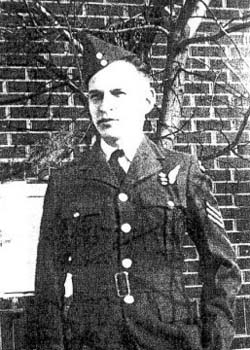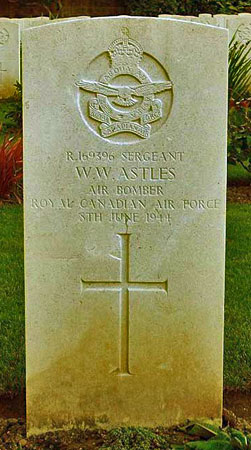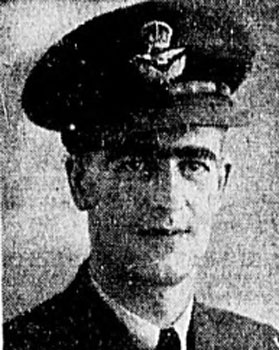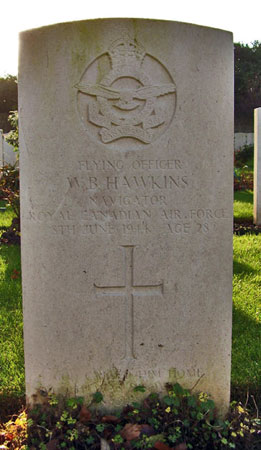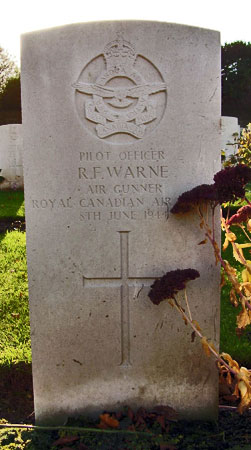Halifax LW279 near Cawton.
On the night of 7th / 8th June 1944 the crew of this 1666 Heavy Conversion Unit aircraft were one of six instructed to undertake night-time Bullseye training flights, this aircraft took off from Wombleton at 22.14hrs. Such Bullseye training exercises were carried out near the end of a Heavy Conversion Unit training course and usually involved the aircrew navigating to a British city and practicing a bombing run there, it would also benifit ground units who would test themselves in setting the range on their equipment and other drills. Of the six 1666 HCU crews that undertook the exercise on this night four completed the flight and made safe landings at Wombleton, another made a safe landing at Woodhall Spa and this sixth would crash before landing. With the exercise all but complete the crew of Halifax LW279 were making their way back to Wombleton, by the time this aircraft had returned to the skies over Ryedale the weather had turned and was by now poor, by 03.30hrs rain and low cloud were present and visibility was worsening. At this time Womblton's flying control attempted to get clearance from Dishforth airfield to get any Wombleton aircraft still in the air to land at Dishforth because of the weather over base, this was refused because Dishforth were expecting returning operational aircraft returning at the same time. Flying control at Wombleton assessed the weather as still fit for landing at Wombleton and received at least one crew safely after 03.30hrs. On the return leg of the flight one of the LW279's engines is believed to have failed and then caught fire. The engine was still seen to be on fire over the Ryedale area. The crew would undoubtably have attempted to have put out the fire in the engine but this would appear to have had no effect. At just before 04.00hrs, the pilot of the aircraft had already lost control, the aircraft descended steeply through the cloud and crashed at a steep angle into rising ground south of Cawton. An explosion and then a fire destroyed the aircraft and all seven airmen stood no chance, they sadly lost their lives. The crash investigation believed that while letting down through cloud to make a landing at Wombleton the pilot lost control of the aircraft, the effects of the engine fire may have contributed in control being lost.
Halifax LW279 was built to contract ACFT/1808/C4/C by the English Electric Company Ltd at Samlesbury and was delivered directly to 429 Squadron at Leeming in mid-September 1943. The unit converted to Halifax MkV's in November 1943 so the aircraft was transferred to 428 Squadron at Middleton St.George. On an unknown date in early 1944 it was transferred to 419 Squadron at Middleton St.George but this was short lived as the unit was converting to Lancasters in March 1944 so it transferred to 1666 HCU at Wombleton for the training role. The aircraft was written off following the incident at Cawton, with Cat.E2/FA Burnt damage being the assessment of the damage. The day before this accident near Cawton the Wombleton station record book states that aircraft "QY-A" suffered from an escape hatch blowing off on take off from Wombleton, Halifax LW279 carried the code "QY-A" at the time.
Pilot - P/O Arthur Taylor Gill RCAF (J/85996), aged 29, of Calgary, Alberta, Canada. Buried Harrogate Stonefall Cemetery, Yorkshire (B/E/6).
Navigator - F/O William Bennett Hawkins RCAF (J/35828), aged 28, late of Winnipeg, Manitoba, Canada. Buried Harrogate Stonefall Cemetery, Yorkshire (B/E/7).
Flight Engineer - Sgt Richard Robert Norman RCAF (R/109152), aged 27, of Bowden, Alberta, Canada. Buried Harrogate Stonefall Cemetery, Yorkshire (B/E/5).
Air Bomber - Sgt William Wallington Astles RCAF (R/169396), aged 23, of London, Ontario, Canada. Buried Harrogate Stonefall Cemetery, Yorkshire (B/E/4).
Wireless Operator / Air Gunner - WO1 William James Banner RCAF (R/127993), aged 24, of Oshawa, Ontario, Canada. Buried Harrogate Stonefall Cemetery, Yorkshire, Yorkshire (B/E/3).
Air Gunner - P/O Rudolph Filmore Warne RCAF (J/39032), of Prince Rupert, British Columbia, Canada. aged 20, of Prince Rupert, British Columbia, Canada. Buried Harrogate Stonefall Cemetery, Yorkshire (B/E/8).
Air Gunner - F/O Thomas Harvey Wilson RCAF (J/39036), aged 19, of Parkman, Saskatchewan, Canada. Buried Harrogate Stonefall Cemetery, Yorkshire (B/E/9).
Arthur "Art" Gill was born on 26th August 1914 in Delburne, Alberta, Canada and was the son of Sidney Arnold and Anne Reba Gill (nee Reynolds). As a young man he studied aeronautics at Calgary technology college between 1934 and 1936 and then started work as a technican for General Radio. In 1937 he became a partner in his own buisness Universal Aircraft. In 1940 he became a partner in Ingram and Gill until enlisting into the RCAF when he sold his interest to his partner. Both companies were involved in servicing aircraft. He married LaRee Neilson on 26th August 1940 in Lethbridge, Alberta. After enlisted into the RCAF on 3rd August 1942 and after basic training as a pilot in Canada he was awarded his Pilot's Wings on 17th September 1943. He was posted to the UK in October 1943 and trained at 11 (P)AFU and 24 OTU. He received a commission to the rank of P/O on 17th April 1944 and was posted to 1666 HCU on 12th May 1944.
Sgt William Astles and his headstone at Harrogate Stonefall Cemetery. He was born on 3rd March 1921 in London, Ontario, Canada and was the son of Charles and Margaret Grace Astles (nee Potter), of Connaught Avenue, London, Ontario. His father was a veteran of the Great War. As a young man he had attended school and college at the Sir Adam Beck Collegiate in London from 1934-1939 before studying nursing at the Ontario Nursing Hospital from 1939 to 1940. He appears to have left without completing the nursing course. His mother died before he enlisted for RCAF service and his leaving the course may have been related to this. In February 1942 he enlisted for service into the Canadian Army and served in the Canadian Postal Corps for six months before transferring to the RCAF and enlisting for aircrew service on 1st July 1942. He enitially trained as a navigator but failed the selection test so re-trained as an air bomber. He was awarded his Air Bomber's badge on 17th September 1943 and was posted overseas to the UK in October 1943. On arrival in the UK he trained at 1 (O)AFU and 24 OTU before posting to 1666 HCU on 12th May 1944.
A F/O John Astles RCAF was killed in February 1944 serving with 408 Squadron and a photograph contained in his service file shows both young men as looking very similar. William's father was born in Lancashire, England and lived at 72 Connaught St, London, Ontario. John's father was born in Manchester, Lancashire, England and then lived at 88 Connaught Ave, London, Ontario. I would suggest that William and John Astles were cousins.
Thomas Wilson was born on 9th February 1925 to John Harvey and Sarah Wilson, of Parkman, Saskatchewan, Canada. His father had moved to Parkman, Saskatchewan from Carlton County, Ontario in 1901 to farm and Thomas was working in farming when he enlisted to Regina on 19th January 1943. He was granted a commission on 26th November 1943 to the rank of P/O which was also when he completed his training in Canada. Wilson Bay in Saskatchewan is named in his honour.
William Banner was born on 17th February 1920 in Chatham, Ontario, Canada and was the son of William Henry and Grace Banner (nee Condon). His father had died when he was a young man.
He left school at fourteen and worked as a shoe salesman and clerk before initially enlisting into the RCAF in September 1940 but was informed that he was to be placed onto a waiting list. He then withdrew his application and begun work as a telegraph operator and was living with his mother in Oshawa, Ontario, Canada. He re-applied to enlist into the RCAF on 26th August 1941 in Toronto and was accepted, after initial training in Canada he was awarded his wireless operator / air gunner's badge on 7th December 1942. For the first half of 1943 he was serving at No.4 Air Observer School possibly as a staff wireless operator. He left Canada on 24th November 1943 and arrived in the UK on 1st December 1943. After training at 4 (O)AFU and 24 OTU he was posted to 1666 HCU on 12th May 1944.
William Hawkins was born on 13th September 1915 to William and Agnes Hawkins of Goven, Saskatchewan, Canada. He was working as a grocer in Winnipeg when he enlisted there on 9th June 1942. He was the husband of Muriel Florence Hawkins, also of Winnipeg, Manitoba, Canada. The Hawkins Lake in Saskatchewan is named his honour.
Richard Norman was born on 1st September 1916 at Olda, Alberta, Canada and was the son of William and Florence (nee Lillywhite) Norman. As a young man he lived in a farming community, working in automotive mechanics and then being a selfemployed mechanic repairing tractors and cars. He enlisted for RCAF service on 2nd July 1941 in Calgary initially serving as an aero engine mechanic in the UK with 400 Squadron in 1942 and 1943. He remustered as aircrew in late-1943 to train as a much needed flight engineer and after training at No.4 School of Technical Training he was posted to 1666 HCU on 7th May 1944. I am seeking a photograph of him.
Rudolph Warne was born on 5th January 1924 at Prince Rupert, British Columbia, Canada and was the son of Frank Warne and Helga (nee Halverson). His Swedish born mother died and his father later re-married. After leaving school in 1942 he worked as a welder in a shipyard. He enlisted for RCAF service on 2nd February 1943 in Vancouver and after training in Canada he was awarded his air gunner's flying badge and also a commission on 26h November 1943. He arrived in the UK in early 1944 and following training at 24 OTU he was posted to 1666 HCU on 12th May 1944.
Ken Reast, Eric Barton, Albert Pritchard and I visited the site in January 2006. It is thought that our party was the first to survey the site in modern times. Fair remains are still to be found on the surface, this is probably due to the soil being very thin and little appears to be far below the surface. What we found was all on the surface. A large proportion of broken pieces of cast alluminium bear witness to the engines and undercarriage being extensively damaged in the crash. The crash site is on private land and permission to access the site was given by Mr Hicks to whom we are most grateful. All items we found were left on the site. The aircraft was believed to have crashed where we are stood.
Pieces of the aircraft found on the surface.
Part of the face of an altimeter.


